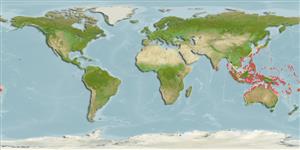Preferred temperature (ссылка
123201): 24.9 - 29.3, mean 28.6 °C (based on 2261 cells).
Phylogenetic diversity index (ссылка
82804): PD
50 = 0.5005 [Uniqueness, from 0.5 = low to 2.0 = high].
Bayesian length-weight: a=0.00389 (0.00180 - 0.00842), b=3.12 (2.94 - 3.30), in cm total length, based on all LWR estimates for this body shape (Ref.
93245).
Trophic level (ссылка
69278): 3.3 ±0.5 se; based on size and trophs of closest relatives
устойчивость к внешним воздействиям (ссылка
120179): низкий, минимальное время удвоения популяции 4.5-14 лет (Assuming Fec < 100).
Fishing Vulnerability (Ref.
59153): Low vulnerability (10 of 100).
🛈
Nutrients (Ref.
124155): Calcium = 180 [97, 341] mg/100g; Iron = 0.98 [0.55, 1.71] mg/100g; Protein = 16.8 [14.2, 19.3] %; Omega3 = 0.105 [0.057, 0.192] g/100g; Selenium = 22.9 [10.9, 55.4] μg/100g; VitaminA = 124 [36, 419] μg/100g; Zinc = 2.59 [1.72, 3.72] mg/100g (wet weight);
